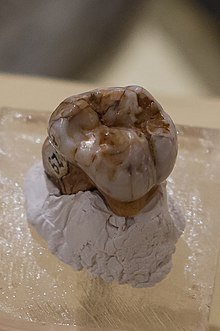 |
| Gut lesbare Angabe des Urhebers neben dem Bild: Thilo Parg / Wikimedia Commons |
Key Concepts:
Denisovans: Denisovans are an extinct group of hominins that were identified through DNA analysis of bone fragments found in Denisova Cave, Siberia, in 2010. Unlike Neanderthals, who have a more substantial fossil record, Denisovan remains are limited to a few bone fragments, including a finger bone, a jawbone, teeth, and skull fragments. Despite the limited physical evidence, genetic studies have shown that Denisovans interbred with modern humans multiple times. Their genetic legacy is particularly evident in modern populations in Asia, Oceania, and the Americas. These interactions have contributed significantly to the genetic diversity of contemporary humans, introducing adaptive traits that have been naturally selected over millennia.
Hominins: This term encompasses all members of the human lineage, including modern humans (Homo sapiens), Neanderthals (Homo neanderthalensis), Denisovans, and their direct ancestors. Studying hominins helps us understand human evolution, shedding light on the various species that have existed, how they interacted, and how they have shaped our genetic heritage. The concept highlights the complexity of human evolution, which is not a straightforward progression but rather a web of interrelated species.
Interbreeding: The process by which different hominin groups, such as Denisovans, Neanderthals, and modern humans, mated and exchanged genetic material. This genetic mixing has had profound implications for the genetic makeup of modern humans. Interbreeding has introduced a variety of beneficial traits that have been passed down through generations, aiding in the survival and adaptation of human populations in diverse environments.
Genetic Locus: A specific location on a chromosome where a gene or genetic marker is situated. Each genetic locus can play a crucial role in determining specific traits or susceptibility to certain diseases. In the context of Denisovan research, identifying loci of Denisovan origin in modern human genomes has provided insights into how these ancient genes continue to influence contemporary human biology.
Hypoxia Tolerance: Adaptation to low oxygen levels, which is beneficial for populations living at high altitudes. Genetic studies have shown that Denisovan genes contributed to this trait in Tibetan populations, allowing them to thrive in the high-altitude environment of the Himalayas. This adaptation enables individuals to cope with the reduced oxygen availability, showcasing the impact of Denisovan interbreeding on modern human physiology.
Lipid Metabolism: The set of biochemical processes involved in the breakdown, synthesis, and utilization of fats in the body. Certain genetic adaptations in lipid metabolism, inherited from Denisovans, have provided advantages for populations living in cold climates. These adaptations enable more efficient heat generation and maintenance of body temperature, which is particularly beneficial for survival in harsh, cold environments such as those inhabited by Inuit populations.
References:
Dr. Linda Ongaro, Prof. Emilia Huerta-Sanchez, et al. "Ancient DNA challenges prevailing interpretations of the Denisovans." Nature Genetics, 2024.